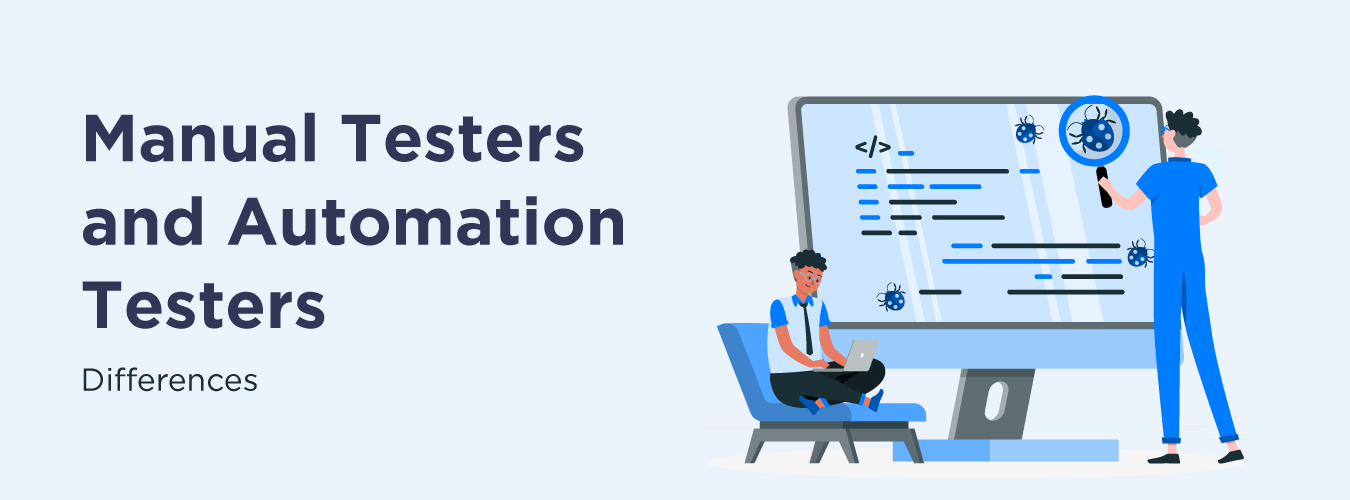Introduction
Ensuring the reliability and functionality of applications is one of the biggest concerns in the fast-paced world of software development. This is where testing comes into play, acting as an entry point for quality software products. As we delve into the intricacies of software testing, two key methodologies emerge manual testing and automation testing. The described techniques have different advantages and traits; they collectively ensure a thorough assessment of software programs.
Table of Contents
- Introduction
- What is a manual tester?
- How does manual testing work?
- What is an automation tester?
- How does automation testing work?
- Difference between manual and automated testing
- Manual Testing vs Automation Testing: Which Approach is the Best Choice?
- Can Automation Testing Replace Manual Testing
- Conclusion
- Frequently Asked Questions
What is a manual tester?
A manual tester is an individual who tests the quality and performance of the software by actually handing it over without any automated tools. By rigorously performing standard test cases, this person will identify and log the defects for the software to behave as required and fulfil its expectations. Manual testers play a vital role in the development life cycle as they execute test scenarios, validate user interfaces, and explore for unexpected issues. Their skills are based on imitating user engagement with the system and its evaluation of the product’s efficiency, convenience, and general worthiness. Manual testing may consume more time than other methods but this is not an alternative to full testing strategies, especially when human intuition is an essential element where one can quickly identify nuance defects.
How does manual testing work?
Manual testing is a procedure in which testers manually implement the test case without using any assistive software. Here’s a brief explanation in the points:
-
Test Planning:
- Specify limits, purposes, and the testing procedure.
- Develop a test plan encompassing test cases, data, and environments.
-
Test Case Design:
- Create highly descriptive test cases by elaborating on requirements and designs.
- Test cases with input values, output results, and executing actions.
-
Test Execution:
- Test cases should be executed on the application or system under test manually.
- Record observed and actual results in comparison with expected findings.
-
Defect Reporting:
- Document all discovered defects or problems during testing.
- Give developers more details for resolution.
-
Regression Testing:
Testing repeat of modified code to check whether any newly included changes are bringing in additional flaws.
-
Ad Hoc Testing:
Use exploratory testing to bring out surprises that were not anticipated earlier.
-
Usability Testing:
Test how friendly it is for users and overall user experiences.
-
Compatibility Testing:
Verify application functionality on various browsers, devices, and operating systems.
-
Performance Testing:
Test the system’s response, scalability, and resource usage by hand.
-
Test Closure:
- Write down test results for stakeholders.
- Complete testing, document it, and put it away for later use.
During initial stages of testing like manual testing and exploratory testing automation may be impossible.
What is an automation tester?
The automation testers design and execute automated testing procedures that evaluate how the software works. Automation testers develop scripts to simplify repetitive testing so that it can be done more efficiently and with less effort. It cooperates with development teams in order not only to supervise code quality but also to define possible test automation and maintain testing frameworks. Testers for automation are an essential factor for shortening the life cycle of software, increasing accuracy, and giving easy responses to software quality. They specialize in making and using test suites that have automated features. This helps them test reliably and quickly.
How does automation testing work?
The application of automated testing utilizes specialized apparatuses intended for running already-composed procedures against a given application by themselves. Testing starts with writing a script for the test (test script), in which testers create code imitating a user interacting with the app. These scripts encompass test cases concerning user input, data processing, and output checking.
The scripts are created and then used to automate testing by employing automated testing tools that either interact with the application’s UI or API. The tools compare the actual and expected results and highlight variances, making reports of such disparities.
With automation testing, there are benefits, including speedy execution of tests, repeatability, and more comprehensive test coverage. It is instrumental in regression testing when it makes sure that there aren’t any defects during the change of already-working functionalities.
Automated testing is standard in many continuous integration and delivery pipelines to speed up the feedback loop on coding changes and improve the quality of the developed software.
Differences between manual and automated testers
-
Nature of Testing:
They include manual testing, where human testers execute test cases without using automation tools. However, automated testing uses scripts and methods to perform the tests under consideration.
-
Speed and Efficiency:
This approach is expensive and usually takes some time. It therefore causes delays during test cycles. On the other hand, automated testing has a shorter execution time, yielding more timely feedback when implementing software changes.
-
Repeatability:
Conditions applied to test cases by various testers are not always the same. Manual testing is also prone to subjective mistakes owing to human nature. Automated software testing offers uniform, similar test settings without human error.
-
Exploratory Testing:
Exploratory testing depends on manual effort as testers use intuition and their understanding of the domain. While automated testing mainly caters to pre-specified test scenarios and, therefore less flexible than an exploratory approach.
-
Initial Setup and Learning Curve:
It requires less setup but is very dependent on human skill. However, the case with Automated Testing is that there is an initial setup and a learning curve regarding developing scripts and mastering the tools themselves.
-
Cost:
Small-scale projects and short-term testing requirements make manual testing much cheaper than other testing types. While automated testing may be more costly initially, it is often cheaper than traditional and frequent repetitious testing.
-
Adaptability to UI Changes:
The manual testing is very flexible, taking any change in the UI structure. However, it can cause modifications to scripts whenever there are UI changes. Hence it can affect the costs involved in performing maintenance activities.
-
Human Judgment:
Regarding detecting problems, manual testing utilises human intuition, perception, and innovative thinking. Automation of testing is not a person in its essence but a machine that cannot make a judgment or follow individual criteria.
-
Suitability for Repetitive Tasks:
Manual testing can be applied for exploratory testing as it brings out the best in human judgment. For instance, automated testing suits well for routine work as well as regression testing provides the same results.
Manual Testing vs Automation Testing: Which Approach is the Best Choice?
The appropriateness of manual testing, as well as automation testing is dependent on the project’s requirement. Exploratory testing and situations in which the intuitions of humans are required are effectively handled through manual testing. In this sense, automation testing suits repeated tasks like regression testing, extensive assignments and assuring productivity. In most cases, this entails integrating exploration and creativity with automation to maximize efficiency and repeatability. Alter the testing strategy depending on project’s end, available resources, and character of the application.
Conclusion
Therefore, whether to conduct automation or manual testing depends upon the goals of a specific project. Human intuition works best on explorative tasks and when creativity matters most. However, automation testing is efficient, repeatable, and fast, which make it suitable for repetitive jobs, regression tests, and massive projects. Arguably, the best way to achieve optimal testing performance is through a combined strategy that combines data-driven and human-based intelligence. It is necessary to choose suitable testing method depending on project conditions, applicable means, and an object of consideration. The project’s adoptable testing strategy will cover the significant points of software development and quality assurance.
Frequently Asked Questions
1. Which is better, a manual tester or an automation tester?
Manual testers are best at exploratory testing, while automation testers are ideal for repetitive and large-scale testing.
2. Can automation testing replace manual testing?
Automation testing helps increase efficiency and improve coverage, but it cannot substitute human participation in exploratory testing and user interface checks.
3. What is the difference between a QA tester and a manual tester?
Overall quality assurance covers test planning and strategy; a QA tester handles this. In contrast, a manual tester’s responsibility is to execute the test cases manually to spot any bugs or defects.









